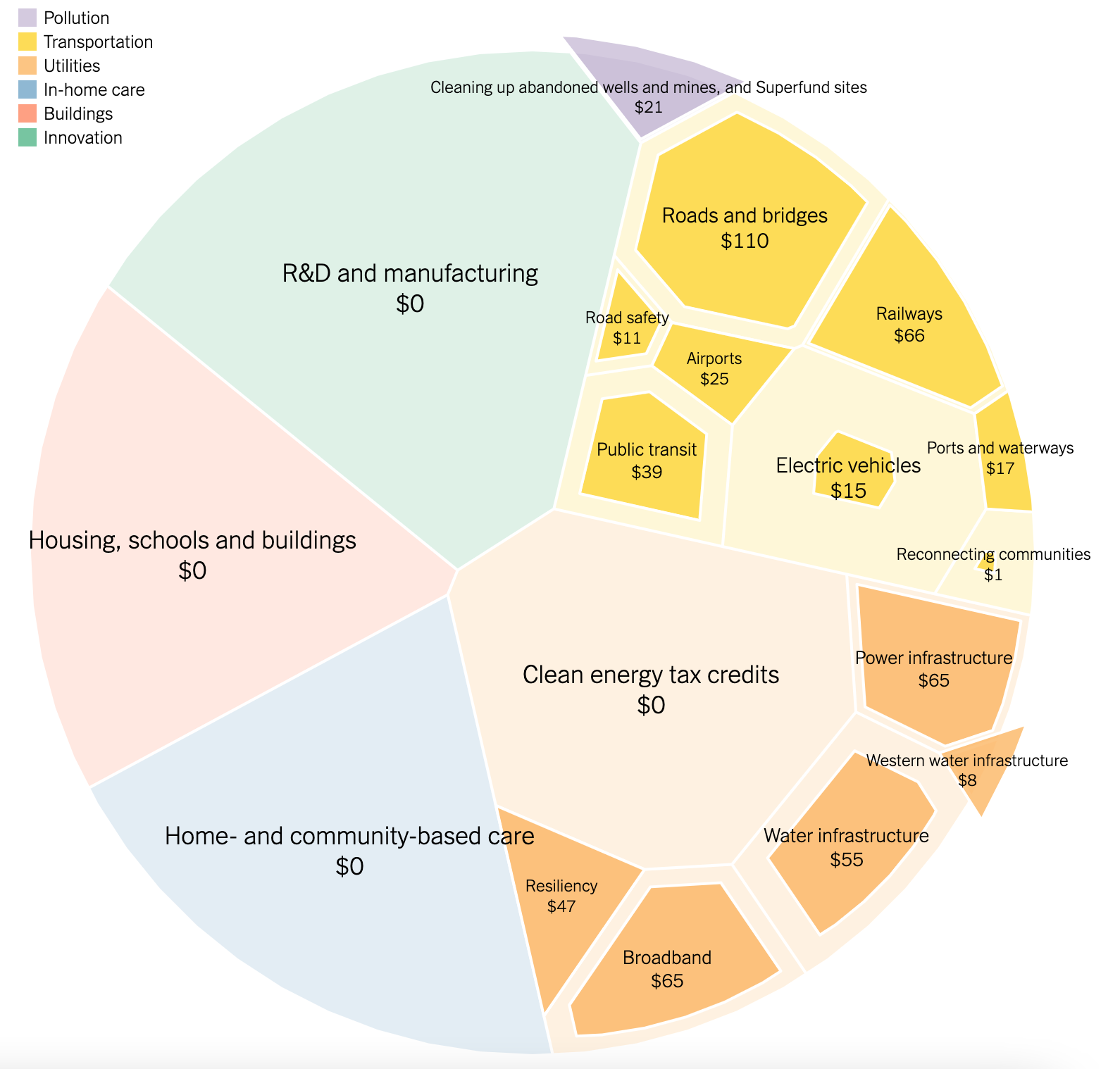
We Have a Deal! Next Up: Acting on the ‘Code Red’ Climate Crisis
Biden's Infrastructure Bill
“After years and years of infrastructure week, we're on the cusp of an infrastructure decade that I truly believe will transform America." - Joe Biden
You heard it right, folks! We have an Infrastructure Deal from a Democratic Administration after 4 years of “infrastructure weak.” And it wasn’t even close. The vote came down to 69-30 with 19 Republicans joining every single Democrat.
Now that the bill has cleared the Senate, the next step is for Senate Democrats to pass their $3.5 trillion Reconciliation Bill (or Infrastructure Part II: Back to the Future) which invests heavily in climate mitigation and families and uses corporate taxes to pay for it all (who said you need a deficit to pass cool things?). That bill can be passed with a majority, meaning that we just need all Senate Democrats and THE Vice President, Kamala Harris, to vote for it.
Nancy Pelosi reiterated again yesterday that she will not bring the Bipartisan bill to the House floor until the Reconciliation bill is passed by the Senate. This ensures that Senamanchin can’t stonewall and fail to pass the most consequential bill for the future of our planet (no biggie).
Monday’s IPCC climate report did not mince words. This report is “a code red for humanity.” Scientists from around the world stated that humans have fueled “unprecedented” climate change, with potentially catastrophic consequences.
The question is no longer can we stave off the climate crisis, but how much damage can we avoid?

Infrastructure: It’s a Start
The $1 Trillion Infrastructure Bill is a step to invest in our communities. Community investment has been in decline since the ’80s when Reagan was president. The common thread was that the government is corrupt so it shouldn’t be trusted and capitalism will work it out eventually. Spoiler alert: that has not happened.
Instead, our roads and bridges are crumbling, rural communities have been underinvested, low-income areas still have lead pipes, and public transportation has not met the need in booming cities.
So what does this bill actually do? Lots of things! Although Republicans and Moderate Democrats helped to shed key areas of investment.
- $110B for roads and bridges
- $66B to improve railways and train travel vs. the original $74B (this was contentious b/c Republicans don’t feel the need to invest in mass transport compared to gas-guzzling cars)
- $65B in broadband internet expansion. This is a game-changer for rural communities.
- $15B to add electric charging stations across the US vs. $157MM needed to expand fully. (This is crucial in making electric vehicles mainstream)
- $55B for water infrastructure vs. $111B proposed. This includes replacing all lead pipes after being banned in the ’80s (I sense a trend).
- $47B in climate resiliency measures to help better withstand the effects of the climate crisis.
The New York Times has a great visual of how the bill has evolved since Biden originally sent his proposal to Congress.

We Need Climate Action Yesterday, But Now’s Good Too
Now don’t get me wrong. The bipartisan infrastructure bill is historic and it is needed.
But what we really need is an investment in our future.
The way I see it, the bipartisan infrastructure bill is a needed investment in our past and present, while the reconciliation bill is an investment in our future. We are a 21st Century country that is still operating in the 20th Century. There are two things that this bill solves for:
- Actually supports families.
- Invests in climate mitigation to stave off the worst and most expensive effects of the climate crisis
Supporting Families
The decline in birth rates has been derided on the Right, but the reality is that the mental and physical cost of affording a family has grown out of control and our society does not support those that want both a family and a career. Among other things, the bill includes:
- The first-ever Federal paid and medical leave benefits. Guaranteeing 12 weeks of paternal leave.
- Universal Pre-K program to help working families (which helps the economy & jobs).
- Enhanced child care to ensure low & middle-income families don’t pay more than 7% of their salary on child care.
- Adds dental, vision, and hearing benefits to Medicare. (how is this not a thing already?)
- Lower the cost of drug prescriptions. (Have you checked the price of insulin lately?)
- Fund the IRS so they can chase wealthy tax cheats and gain more in tax revenue
Climate Mitigation
When it comes to climate action, there’s a bit of a chicken before the egg situation going on. Except no one can decide if they’re the egg or the chicken.
Corporations can only do so much before the federal government needs to get involved. Unlike corporations, the government can use its might to provide incentives for individuals and corporations to “go green” and investment to accelerate the growth of key sectors that are needed to shift our economy to a green economy.
The Reconciliation bill would put climate mitigation efforts into a much-needed path. Here’s just a few things the bill would do for climate:
- Reduce economy-wide carbon emissions by 50% by 2030.
- Make 80% of US power grid generated from emissions-free sources before 2030.
- Consumer rebates for home electrification and weatherization.
- Provide clean energy, manufacturing, and transportation tax incentives and grants.
- Electrifying the federal vehicle fleet and buildings.
- Agricultural conservation, drought, and forestry programs.
This week is a cause for celebration! Biden promised big changes and the passage of the Bipartisan bill gets him one step closer to that reality.
The question is can the government invest in climate now to avoid the cost of extreme climate?
the roots of change media Newsletter
Join the newsletter to receive the latest updates in your inbox.



